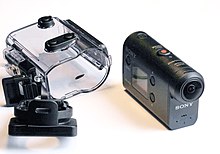As of 1 April 2016, Sony is organized into the following business segments: Mobile Communications (MC), Game & Network Services (G&NS), Imaging Products & Solutions (IP&S), Home Entertainment & Sound (HE&S), Semiconductors, Components, Pictures, Music, Financial Services and All Other.[29] The network and medical businesses are included in the G&NS and IP&S, respectively.[30]
Electronics
Sony Corporation
Audio
Sony produced the world's first portable music player, the Walkman in 1979. This line fostered a fundamental change in music listening habits by allowing people to carry music with them and listen to music through lightweight headphones. Walkman originally referred to portable audio cassette players. The company now uses the Walkman brand to market its portable audio and video players as well as a line of former Sony Ericsson mobile phones.Sony utilized a related brand, Discman, to refer to its CD players. It dropped this name in the late 1990s.
Computing
Sony produced computers (MSX home computers and NEWS workstations) during the 1980s, exclusively for sale in the Japanese market. The company withdrew from the computer business around 1990. Sony entered again into the global computer market under the new VAIO brand, began in 1996. Short for "Video Audio Integrated Operation", the line was the first computer brand to highlight visual-audio features.[21]Sony faced considerable controversy when some of its laptop batteries exploded and caught fire in 2006, resulting in the largest computer-related recall to that point in history.[31][32][33]
In a bid to join the tablet computer market, the company launched its Sony Tablet line of Android tablets in 2011. Since 2012, Sony's Android products have been marketed under the Xperia brand used for its smartphones.[34]
On 4 February 2014, Sony announced that it will sell its VAIO PC business due to poor sales[35] and Japanese company Japan Industrial Partners (JIP) will purchase the VAIO brand, with the deal finalized by the end of March 2014.[36] Sony maintains a minority stake in the new, independent company.
Photography & videography
A Sony Action-camera with underwater housing
The first Cyber-shot was introduced in 1996. At the time, digital cameras were a relative novelty. Sony's market share of the digital camera market fell from a high of 20% to 9% by 2005.[21]
Sony entered the market for digital single-lens reflex cameras in 2006 when it acquired the camera business of Konica Minolta. Sony rebranded the company's line of cameras as its Alpha line. Sony is the world's third largest manufacturer of the cameras, behind Canon and Nikon respectively.
There are also a variety of Camcorders which are manufactured by Sony.
Video
In 1968 Sony introduced the Trinitron brand name for its lines of aperture grille cathode ray tube televisions and (later) computer monitors. Sony stopped production of Trinitron for most markets, but continued producing sets for markets such as Pakistan, Bangladesh and China. Sony discontinued its series of Trinitron computer monitors in 2005. The company discontinued the last Trinitron-based television set in the USA in early 2007. The end of Trinitron marked the end of Sony's analog television sets and monitors.Sony used the LCD WEGA name for its LCD TVs until summer 2005. The company then introduced the BRAVIA name. BRAVIA is an in house brand owned by Sony which produces high-definition LCD televisions, projection TVs and front projectors, home cinemas and the BRAVIA home theatre range. All Sony high-definition flat-panel LCD televisions in North America have carried the logo for BRAVIA since 2005. Sony is the third-largest maker of televisions in the world.[37] As of 2012, Sony's television business has been unprofitable for eight years.[37]
In December 2011, Sony agreed to sell all stake in an LCD joint venture with Samsung Electronics for about $940 million.[38] On 28 March 2012, Sony Corporation and Sharp Corporation announced that they have agreed to further amend the joint venture agreement originally executed by the parties in July 2009, as amended in April 2011, for the establishment and operation of Sharp Display Products Corporation ("SDP"), a joint venture to produce and sell large-sized LCD panels and modules.[39]
On November 9, 2015 Sony announced that they are going to stop producing Betamax Tapes in March 2016.[40]
Sony also sells a range of DVD players. It has shifted its focus in recent years to promoting the Blu-ray format, including discs and players.


No comments:
Post a Comment